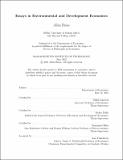Essays in Environmental and Development Economics
Author(s)
Hsiao, Allan
DownloadThesis PDF (5.302Mb)
Advisor
Agarwal, Nikhil
Duflo, Esther
Olken, Benjamin
Terms of use
Metadata
Show full item recordAbstract
Chapter 1. Weak environmental regulation has global consequences. When domestic regulation of carbon-intensive industries fails, the international community can intervene by targeting these industries with import tariffs. I argue that import tariffs must possess two features – coordination and commitment – in order to be effective. Without coordination across importers, tariffs are undermined by leakage to unregulated markets. Without commitment to upholding tariffs over the long term, tariffs are reduced over time as importers give in to static incentives. I develop a dynamic empirical framework for quantifying these forces in settings with incomplete regulation and sunk investment, and I apply it to the market for palm oil, a major driver of deforestation and one of the largest sources of emissions globally.
Chapter 2. Does electoral accountability discipline public spending? After the fall of Suharto, Indonesia held local elections for the first time in decades. I use a dynamic discrete choice framework to study how democratization affected the spatial allocation of public investment in healthcare infrastructure. On one hand, democratization limits distortions from Suharto-era biases toward certain areas, such as those within the patronage network. On the other hand, spillover effects are less internalized as districts become more focused on their own constituents.
Chapter 3. Many infrastructure investments have spatial effects that make optimal allocation a difficult, combinatorial problem. Schools are one such example: when graduates seek employment nationally and migrate, schools have effects that extend beyond local labor markets. But policymakers often allocate infrastructure investments with simple rules like population cutoffs, ranked lists, and need-based formulas that do not account for spatial interdependencies. How effective are these simple rules compared to more sophisticated approaches? I use a spatial equilibrium model of individuals’ education and migration decisions to study this question in the context of Indonesia’s Sekolah Dasar INPRES program, the largest school construction program in history.
Date issued
2021-06Department
Massachusetts Institute of Technology. Department of EconomicsPublisher
Massachusetts Institute of Technology